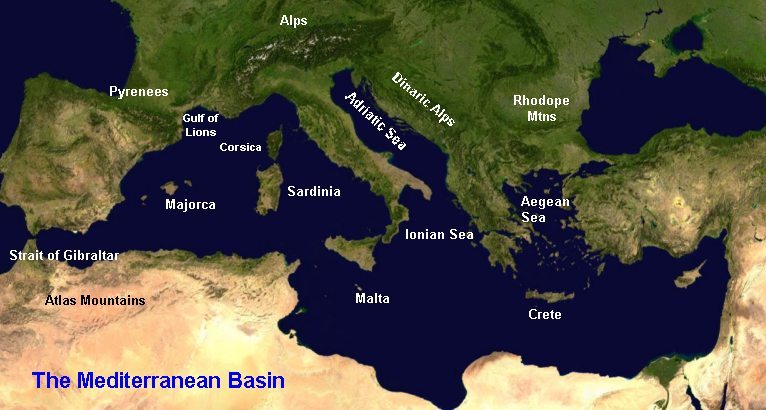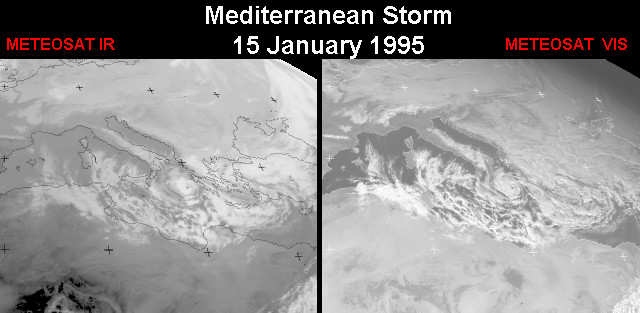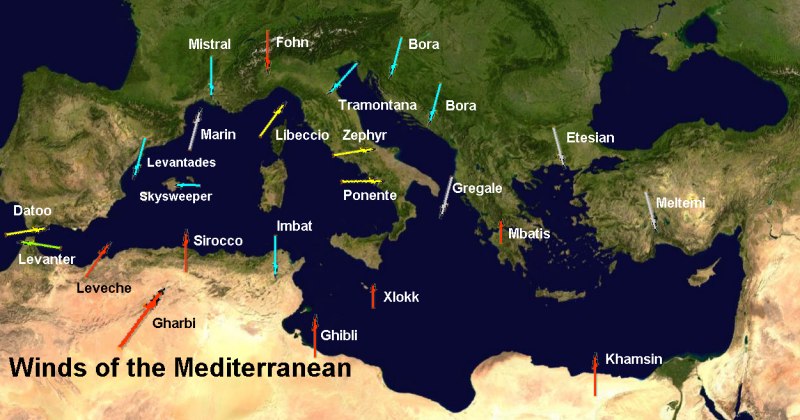 |
 |
| Home | Welcome | What's New | Site Map | Glossary | Weather Doctor Amazon Store | Book Store | Accolades | Email Us |
 | |||||||||
Weather Almanac for March 2007THE MEDITERRANEAN: BIRTHPLACE OF THE WINDSMarch is the traditional month associated with winds, harsh as a lion or gentle as a lamb. I keep with that tradition by focusing this month's Almanac on the winds of one specific region where they have played a prominent role in shaping the region: the Mediterranean basin. It is said that there are thousands of names for the wind there including: bora, sirocco, tramontana, maestro and xlokk. Humans all across the globe have been at the mercy of the winds, blowing good and ill, since time immemorial. The civilizations rising in the Mediterranean basin, which is the forerunner of my nation's and my own ancestry, gave veneration to the winds as well as early explanations, and they have left us with a colourful vocabulary of names for the winds. It is for this reason I call the Mediterranean the "birthplace of the winds."
The winds that blow through and across the Mediterranean Basin control the lives of the peoples of the region in many ways. Of course, they brought weather, both good and bad, but they also controlled much of the early commerce which revolved around sail-driven marine traffic to spread goods around the region. Often, the winds affected the outcome of warfare as many battles depended on naval vessels. The Mediterranean BasinThe Mediterranean Basin contains the Mediterranean Sea and its surrounding shorelines. It also extends inland to the north approximately to the ridge line of the Pyrenees, the Alps, and the Dinaric Alps. The Atlas Mountains form a good boundary for the southwestern Mediterranean but in the southeast, the basin fades away somewhere within the Sahara Desert. On the west, the Strait of Gibraltar forms the limit of the Mediterranean Sea and basin, and in the east, the central mountains of the Anatolian Peninsula of Turkey separate the Mediterranean from the Black Sea. To the southeast, the coastline of the Middle East forms the eastern end the basin.  The basin formed as the tectonic plates of Africa and Arabia moved northward toward the Eurasian plate closing the Neotethys Sea. The collision formed the east–west mountain chain of southern Europe that forms the basin's northern extent. At one time, about 6 million years ago, the basin was closed off from the Atlantic Ocean and the sea waters evaporated. The link, around today's Strait of Gibralter, reopened at the end of the Miocene and the Mediterranean Sea again filled. The Mediterranean Sea (I refer here to the continuous body of water from the Strait of Gibralter to the Middle East which includes a number of large bays and gulfs, many of which have been named seas such as the Adriatic Sea) encompasses covers an approximate area of 2.5 million km2 (965,000 mi2), extending over about 15 degrees of latitude and 40 degrees of longitude. It has an average depth of 1,500 metres (4900 ft) with its deepest recorded point at 5267 metres (about 3.27 miles) in the Ionian Sea. The water's great depth across the basin means the sea temperature changes little with the seasons, thus its surface waters are generally warmer in the cold months and cooler during the peak warm months. The Mediterranean ClimateThe climate of the Mediterranean Basin is so unique that it has been used to name a regional climatic subtype of similar conditions found around the world, most notably coastal California and coastal areas of southwest Australia, Chile and South Africa. The Mediterranean climate is characterized by moist, mild winters and hot, dry summers. Such conditions are, naturally, found within the Mediterranean Basin. Since the basin is quite long, there is a general difference between the western and eastern basin climates, with more continentality (greater temperature extremes) in the east. Of course, the topography around the coastlines also contain mesoclimatic variations. Despite such variations, a general picture of the basin can be painted of the general climate around the coastline of the Mediterranean Sea. Temperature varies greatly across, the annual mean varying from 13 to 25 oC (56 to 77 oF). In the west the Atlantic influence limits the mean annual range to about 5.6-6.7 Co (10-12 Fo), but in the east this increases to 20-22 Co (36-40 Fo). In the winter, temperatures rarely drop below 5 oC (41 oF) except at higher elevations, most likely averaging 12 to 13 oC (53 to 55 oF), and frosts are rare near the water. In the summer average temperatures can rise up to 27 oC (80 oF). Sunshine in abundant the year-round. The transition seasons tend to be different than in the mid-latitudes. Spring slowly shifts from the mild winter to full summer which may not begin until early July. As a result, summer extends later into the year and October sees the beginning of a short autumn. Rainfall in summer is low and spotty as the subtropical high pressure region extends further north into the basin and inhibits cloud formation. In winter, the warmer waters of the sea spawn a regional trough of low pressure which, combined with the southward bulge of the polar front, causes increased cyclonic activity and cloudiness and an increase in precipitation, mostly falling as rain. Most snow falls at higher elevations, though it can push down into coastal regions when the coldest air masses slip southward from northern Europe. The western basin is generally wetter than the eastern areas. The Winds of the MediterraneanAs with most regions within the middle latitudes (Rome is at the same latitude as Chicago), the regional prevailing winds are westerly with a northwesterly lean and traverse the Mediterranean Sea longitudinally. The mountain ranges that define the basin also help to define the wind climate of the region and its sub-regions. Mesoscale circulations — sea-land breezes, mountain gap winds, elevation fall winds, valley winds, etc. — are climatic factors which affect local climates around the basin, particularly in summer when the Mediterranean waters are cool compared to the hot land masses surrounding it. In the other seasons, however, cyclonic storm systems become dominant. During the winter months, the Mediterranean is a hotbed for cyclogenesis, the birthing of low pressure systems. Climatologists believe the Mediterranean region has the highest concentration of locally developed cyclones on the planet, at least during the winter.  On occasion, some of these storms develop into monster storms resembling Atlantic hurricanes, though they are not true tropical storms. These Mediterranean cyclones have similar characteristics to tropical cyclones and polar lows in their structure, but are smaller and generally less destructive than the Atlantic and Pacific tropical storms. During the last sixty years, five Mediterranean cyclones have brought hurricane-like conditions to the region: September 1947, September 1969, January 1982, September 1983, and January 1995. Local WindsLike the number of Eskimo/Inuit words for snow, the list of named winds in the Mediterranean has been touted as being very long, perhaps numbering a thousand. I have no doubt the list should long. The history of this region of the world extends for many millennia, and the number of cultures and languages, alive and dead, to furnish such words is also great. Add to this the rugged topography of the lands surrounding the Mediterranean Sea and the islands within it, and the picture becomes more and more complex, leading to many local descriptive words for the ever present winds. Several of these local wind names have been taken by meteorologists to define their category. The most famous is the föhn (or foehn) wind. The föhn is a warm dry wind formed by the compression of air as it descends from high elevations. In North America, this wind is called the chinook and the Santa Ana. The hot, very dry sirocco wind is a desert wind often carrying dust long distances that it also goes by the name of simoom (Arabia), ghibli (Libya), harmattan (Algeria), haboob (Sudan) and khamsin (Egypt). The bora is a wind similar to the föhn in origin, but that begins cold and does not have sufficient descent to warm greatly. As a result, the bora is a cold wind when it reaches the coast or lowlands. Bora offspring include the mistral in the Rhone Valley of France and the jasna burna in Croatia. (Today, the bora-type winds are generally classified as cold katabatic winds.)  The following list of wind names for the region is by no means complete. I have chosen some of the more well known and more poetic (as I perceive their pronunciation). They come from many lands and bring to the population heat and cold, dust and rain, relief and misery.
Learn More From These Relevant Books
|
|||||||||
 |
To Purchase Notecard, |
Now Available! Order Today! | |
 |
 |
NEW! Now |
The BC Weather Book: |






